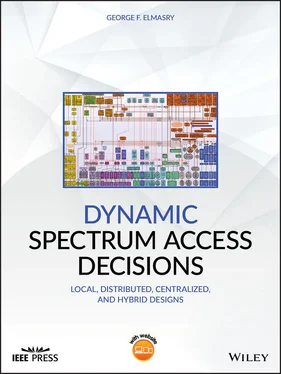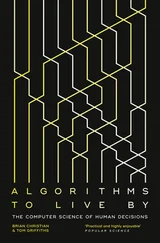15 Lehtomäki, J., Vartiainen, J., Juntti, M., and Saarnisaari, H., Spectrum sensing with forward methods. In Proceedings of the IEEE Military Communications Conference, Washington, D.C., USA, October 2006.
16 Leu, A., McHenry, M., and Mark, B., Modeling and analysis of interference in listen‐before‐talk spectrum access schemes. International Journal of Network Management, vol. 16, pp. 131–147, 2006.
17 Marcus, M., Unlicensed cognitive sharing of TV spectrum: the controversy at the federal communications commission. IEEE Communications Magazine, vol. 43, no. 5, pp. 24–25, 2005.
18 Mathur, C.N. and Subbalakshmi, K.P., Digital signatures for centralized DSA networks. In First IEEE Workshop on Cognitive Radio Networks, Las Vegas, Nevada, USA, January 2007, pp. 1037–1041.
19 Mitola, J., Cognitive Radio An Integrated Agent Architecture for Software Defined Radio. PhD thesis, KTH Royal Institute of Technology, Stockholm, Sweden, 2000.
20 Mitola, J., Cognitive Radio Architecture, in Cognitive Networks: Towards Self‐Aware Networks (ed. Q.H. Mahmoud). John Wiley & Sons, Chichester, 2007. doi: 10.1002/9780470515143.
21 Naraghi‐Pour, M. and Ikuma, T., Autocorrelation‐based spectrum sensing for cognitive radios. Proceedings of the IEEE Transactions on Vehicular Technology, vol. 59, no. 2, February 2010.
22 Papadimitratos, P., Sankaranarayanan, S., and Mishra, A., A bandwidth sharing approach to improve licensed spectrum utilization. IEEE Communications Magazine, vol. 43, no. 12, pp. 10–14, December 2005.
23 Pawełczak, P. Janssen, G.J., and Prasad, R.V., Performance measures of dynamic spectrum access networks. In Proceedings of the IEEE Global Telecommunications Conference (Globecom), San Francisco, California, USA, November/December 2006.
24 Rossi, P., Ciuonzo, D., and Romano, G., Orthogonality and cooperation in collaborative spectrum sensing through MIMO decision fusion. Proceedings of the IEEE Transactions on Wireless Communications, vol. 12, no. 11, November 2013.
25 Shobana, S., Saravanan, R., and Muthaiah, R., Matched filter‐based spectrum sensing on cognitive radio for OFDM WLANs. International Journal of Engineering and technology, vol. 5 no 1, February 2013.
26 Sun, Z., Bradford, G., and Laneman, J., Sequence detection algorithm for PHY‐Layer sensing in dynamic spectrum access networks. Proceedings of the. IEEE Journal of Selected Topics in Signal Processing, vol. 5, no. 1, pp. 97–109.
27 Yucek, T. and Arslan, H., A survey of spectrum sensing algorithms for cognitive radio applications. IEEE Communications Surveys and Tutorials, vol. 11, no. 1, first quarter 2009.
1 1Please reference Appendix 2A for an explanation of the use of the term “energy detection” in spectrum sensing.
2 2 Notice that dB is a logarithmic scale that is used to describe the ratio of signal to noise.
3 3 WiFi is a trademarked phrase that means IEEE 802.11.
4 4 Opportunistic use of a spectrum by a secondary user is one example of opportunistic spectrum use. The more common opportunistic spectrum use is with unlicensed frequency bands where any user looks for spectrum holes to transmit on.
5 5 This one unit of energy can be dependent on the sensing time period.
6 6The reader can refer to digital communications specialized references on how a signal is constructed in multidimensional SiS.
7 7With same‐channel in‐band sensing, T is well correlated to the dwell time, as explained in Chapter 3.
8 8 M is typically a power of 2. With a binary antipodal signal, M = 2. With a 4‐ary phase shift keying signal, M = 4. With 8‐ary phase shift keying, M = 8. QAM signals can be 16, 32, 64, etc. Except for the binary antipodal signal, which has one direction, all of these examples have a two‐dimensional signal (i.e., N = 2). Orthogonal signals can have higher dimensions.
9 9 Statistical decisions in symbol detection also have a probability of false alarm and a probability of misdetection. However, both probabilities result in detecting the wrong symbol and hence most signal detection techniques are interested in the probability of symbol error without the distinction between the probability of false alarm and the probability of misdetection.
10 10 The differences between S(t) and S*(t) are two‐fold. The first difference is the added noise in S*(t). The second difference, which can have a larger impact, is the time lag between the samples of S*(t) and S(t). If the time lag is zero, S*(t) is aligned to S(t) and this process becomes a convolution process.
11 11 Signal detection using autocorrelation can also happen in frequency domain where noise covariance can be better estimated.
12 12 OFDM is used in both commercial and defense signals. Commercial signals include WiMAX, LTE 5 MHz, LTE 20 MHz, and 5G. Defense signals include the wideband networking waveform (WNW) and the soldier radio waveform (SRW).
13 13 This opportunistic use can be by another commercial signal or a military signal.
14 14 All the jammer needs to do is to jam enough frequency slots to cause error patterns that make the military signal error correction coding fail to correct the error patterns. This type of spectrum sensing is a cat and mouse game. The defense signal platform spectrum sensing can monitor if the jammer succeeds in overcoming the defense signal before switching the signal to a different mode or using another signal type.
15 15 Spread spectrum based sensing was covered earlier in this chapter.
16 16 The preambles mentioned here are different from the time domain preamble, which is a sequence of symbols in the transmitted frame. The preambles here are frequency domain preambles.
17 17 In defense applications, this area of operation is referred to as the theater of operation.
18 18Wavelet transform is widely used in digital image processing. With spectrum sensing, it can be used with sensing signals that use a wideband.
19 19 An even signal is symmetric around the vertical axes. An odd signal is symmetric about the origin.
Chapter 3 Receiver Operating Characteristics and Decision Fusion
Receiver operating characteristic (ROC) is not a unique methodology to DSA decision making. It is widely used in many areas where statistical decisions are adaptively made based on myriad metrics. ROC is a generic approach developed for low computational and implementation complexities. This chapter covers different DSA scenarios that rely on using ROC models. A ROC model can be used when probing a frequency band to discover if it is occupied or not at a certain geographical location (e.g., a secondary user is sensing if a primary user is using this frequency band or not). Another scenario that uses a different ROC model is the case of same‐channel in‐band sensing where the ROC model can hypothesize the presence or absence of an interfering signal. The detected energy of the sensed frequency band is compared to an adaptive threshold to hypothesize the presence of the interfering signal. This threshold adaptation is highly dependent on noise estimation and is decided based on tradeoffs driven by the design needs. Estimating ROC models' thresholds can be challenging when noise variance increases and when signal power is too low. 1The spectrum sensor can be looking into interference from other signals overlaid with the noise without being able to distinguish between the interfering signal power and the noise power. In other cases, the spectrum sensor can be looking at an overlay of different signals occupying the same frequency band. This can mislead the decision‐making process and result in increasing the probability of false alarm and of misdetection. 2
With DSA, the ROC methodology can be implemented in different approaches depending on the sensing metrics and where the decision is made. This chapter will start with the generic aspects of the ROC hypothesizing process in DSA applications and present simple ROC‐based decision fusion cases while gradually moving to the harder cases. Statistical decision models in modulation and coding are well studied and well presented in textbooks. This chapter covers decision models for spectrum sensing pointing to the similarities and difference with modulation and coding models. While a demodulator may use fixed thresholds and rely on well‐known statistical models such as AWGN and the communication signal known power spectral density characteristics to decode a symbol, spectrum sensing models use adaptive thresholds and machine learning techniques to account for the many factors that can compound the spectrum sensing hypotheses. If the reader is not familiar with the ROC models, the reader is encouraged to refer to Appendix A of this chapter to get some basic understanding of the ROC methodology.
Читать дальше












